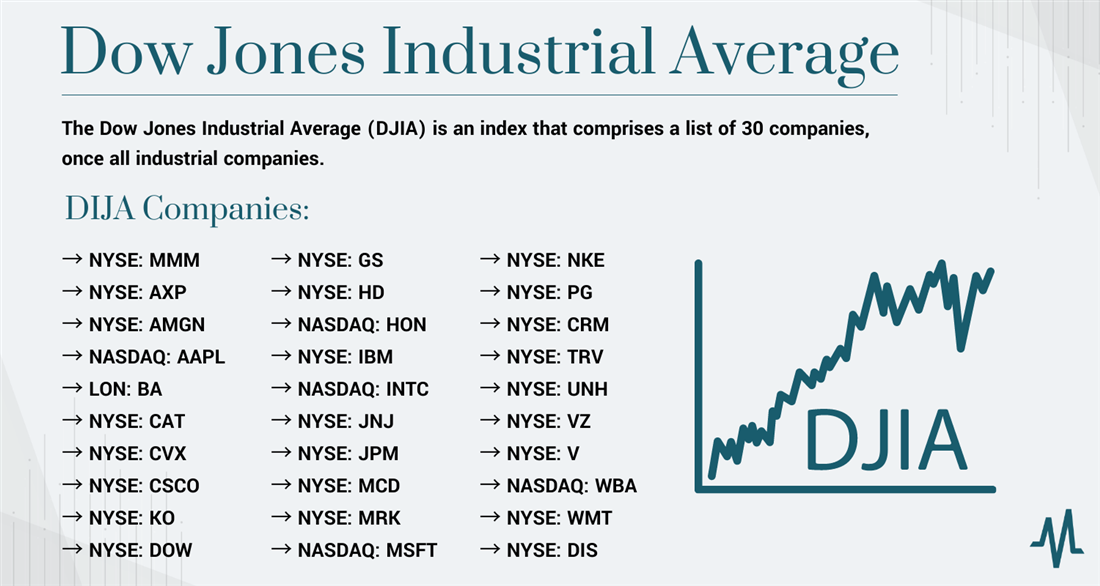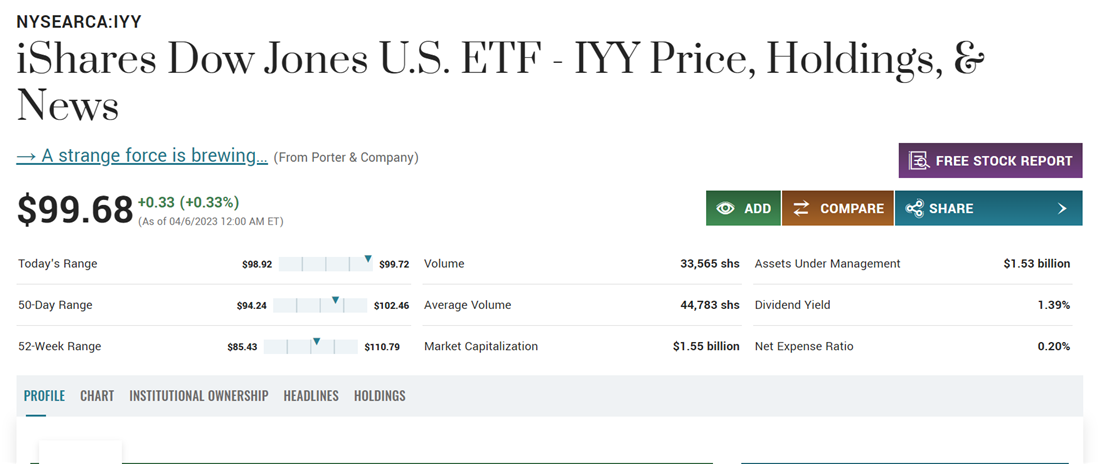The Dow is a stock index that tracks the performance of 30 large, publicly traded companies listed on stock exchanges in the United States. Stocks in the Dow Jones represent major consumer goods companies, many of which you'll recognize as everyday products. Read on to learn more about what stocks are in the Dow and how you can invest in other major indexes.
Overview of Companies in the Dow
The DJIA is a stock market index designed to quickly measure the overall health of the American economy, similar to other major indexes. You can view an overview of market indexes on MarketBeat to learn more about the importance of indexes and the function they serve in the economy.
How many stocks are in the Dow Jones Industrial Average? The Dow currently includes 30 of the largest stocks in the country, which has been the set number of stocks in DIJA since 1928. While the number of stocks on the Dow has fluctuated over time, the number of included companies will remain at 30 for the foreseeable future.
What stocks are in the Dow? As of April 2023, the stocks in the Dow Jones currently includes all of the following publicly traded companies:
Editors of The Wall Street Journal (owned by Dow Jones & Company) are responsible for selecting and rebalancing the index. The editors consider various factors when deciding which companies to include but generally focus on large, well-established companies with a history of stable earnings and a solid reputation in their industry.

History of the Dow Jones Industrial Average (DJIA)
The Dow Jones Industrial Average was first created in 1896 by Charles Dow, the co-founder of Dow Jones & Company. At the time, the index included just 12 companies, all in the industrial sector.
Over the years, the composition of the DJIA has changed several times. The number of stocks in the Dow included in the index has increased from 12 to 30, and the industries represented in the index have broadened beyond just industrial companies. The first changes to the index came in 1916, when the number of companies increased to 20, and then again in 1928, when the number of companies grew to 30 (where it has remained ever since).
Today's stocks in the Dow 30 are all recognizable names in major industries, including retailers like Walmart and tech companies like Microsoft. The Dow uses a price-weighting strategy and includes only a select group of industry leaders, setting it apart from other indexes. However, many of the major players in each category are the same between index calculations, so you'll find overlap with roundups like this list of FAANG stocks on MarketBeat.
While the DJIA is a major index, it is not the only way to measure the overall health of the American economy. The following major indexes complement the Dow—while they may share some of the same assets, different weighting and inclusion criteria make them unique.
Nasdaq Composite Index
The Nasdaq Composite Index is a stock market index that tracks the performance of more than 3,000 publicly traded companies listed on the Nasdaq stock exchange. The Nasdaq exchange is primarily known for listing technology and growth-oriented companies, but it also includes companies from other sectors such as healthcare, consumer services and finance.
Unlike the DJIA, which includes just 30 large-cap U.S. companies, the Nasdaq Composite Index is a broader market index that includes companies of all sizes and from various industries. Additionally, the Nasdaq Composite Index is a market-capitalization-weighted index, meaning that companies with larger market capitalizations have a more significant impact on the index's performance. This is in contrast to the Dow, which is a price-weighted index.
Overall, the Nasdaq Composite Index will give you a broader understanding of market price movements, while the Dow shows the performance of a select grouping of companies. If you don't have time to review the entire index, browse this selection of the best NASDAQ stocks to buy compiled by MarketBeat.
S&P 500 Index
The S&P 500 Index is a market-capitalization-weighted index of the 500 largest U.S. companies operating on publicly traded markets. Companies included in this index are chosen based on total market capitalization, liquidity and industry sector representation. The S&P 500 index is designed to represent a broad cross-section of the U.S. economy and includes companies from a range of industries. You can view a complete list of S&P 500 stocks.
Like the Nasdaq Composite Index, the S&P 500 Index is a broader market index than the DJIA, as it includes many companies and covers a wider range of industries. However, unlike the Nasdaq Composite Index, the S&P 500 Index only includes companies based in the United States.
Also, unlike the DJIA, the S&P 500 features a market-weighted calculation, which means that companies with more assets under control make up a larger percentage of the index. The DJIA's price-weighting structure gears the index more heavily towards assets with higher share prices. Learning more about comparing stocks on MarketBeat or using another market news source can help you incorporate multiple indexes with different weighting structures into your portfolio.
Russell 2000
The Russell 2000 is another stock market index designed to track the performance of small-cap U.S. companies. The index comprises the smallest 2,000 companies in the Russell 3000 Index, a broader market index covering 3,000 U.S. companies.
The Russell 2000 Index varies from the Dow Jones Industrial Average in several ways. First, the Russell 2000 Index covers a different segment of the U.S. stock market, focusing on small-cap companies rather than large-cap companies. The DJIA includes only 30 large-cap U.S. companies, while the Russell 2000 Index covers a much larger number of smaller companies. This means that, like the Nasdaq Composite and the S&P 500, the data you receive from the Russell 2000 is more generalized across multiple market sectors, rather than individual companies.
2 Ways to Invest in Dow Stocks
Now that you understand what stocks are in the Dow Jones and how the DJIA index is calculated, it's time to learn about practical ways to invest in the DJIA's assets. The following are 2 of the most common ways to invest in stocks that comprise the Dow.
Individual Stocks
The Dow comprises 30 individual stocks, which you can buy and sell as individual shares using a brokerage account. Research the companies that make up the Dow using the list above and select a few to add to your portfolio. Then, place a buy order through your brokerage account of choice. Monitor your stocks' performance over time, and consider tax considerations for any dividends you receive.
ETFs
If you're looking for a faster and easier way to invest in all of the stocks that make up the DJIA, you may want to consider a Dow Jones ETF. An exchange-traded fund (ETF) is a managed grouping of stocks that trades daily as a singular asset. Dow Jones ETFs are composed of the stocks that make up the Dow, allowing you to invest in a weighted grouping without placing 30 individual buy orders. Some examples of DJIA ETFs include the SPDR Dow Jones Industrial Average ETF (NYSE: DIA) and the iShares Dow Jones U.S. ETF (NYSE: YYY).

Image: The iShares Dow Jones U.S. ETF is one of the ETFs that track the performance of the DJIA index.
Pros and Cons of Investing in Dow Stocks
Understanding both the pros and cons of investing in the assets that make up the Dow Jones Industrial Average is essential to any investor. Be sure to consider all of the following points before placing a buy order, and consider consulting with a financial professional before making any major financial decisions.
Pros
First, the benefits:
- Diversification: The Dow comprises 30 large, established companies from various industries, which can provide an instant level of diversification for your portfolio. A DJIA ETF can make the process of diversifying and protecting your initial investment even simpler.
- Long-term growth potential: Many of the companies in the Dow have a long history of success and stability and may continue to grow over the long term. Editors at the Wall Street Journal actively reassess and evaluate the assets in the Dow, offering professional oversight you won't get through individual investing on your own.
- Dividends: Many stocks in DJIA pay dividends, which can provide a source of regular income for investors.
Cons
Next, the downsides:
- Concentration: The Dow only tracks 30 companies, so your investments may concentrate on a few key industries. This can lead to higher rates of losses if the specific sectors you're buying into see sharp losses.
- Limited exposure: The Dow is only made up of U.S.-based companies so investors may miss out on opportunities for international exposure. This can also lead to concentrated losses if the American economy turns negative.
Consider Investing in the Dow
There's a reason why the DJIA has remained a significant stock indicator since its inception more than 100 years ago. The companies that make up the Dow are mainstays of the American economy, proving their worth by weathering through both bull and bear markets. However, new investors, in particular, need to remember that the stocks that make up the Dow represent only a small section of the American economy — and diversify accordingly.
FAQs
Take a look at some frequently asked questions about investing in the Dow and stocks in Dow.
What stocks make up the Dow?
The Dow comprises 30 American companies, each representing a major name in its sector. Some examples of well-known companies that make up the Dow include UnitedHealthcare, Coca-Cola and JP Morgan Chase.
How many stocks are in the Dow?
There are currently 30 stocks in the Dow, which has been the case since 1928. While the Dow Jones has changed the number of companies included in the index in the past, it is now set at 30.
What is the biggest company in the Dow?
As of April 2023, the largest company in the Dow Jones Industrial Average by market capitalization is Apple, which makes up about 13% of the index.
